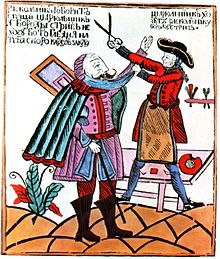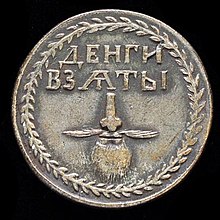Beard tax
The beard tax was at in historical times beards raised state fees. The best known is the tax levied in Russia at the instigation of Tsar Peter I for predominantly Old Believers who wanted to keep their beard against the will of the Tsar. But there were also decisions elsewhere to use beards to solve financial problems.
Russia
Circumstances of the time
Tsar Peter I had the impression that in Russia of his time they clung to old traditions too much and that the country needed modernization in some areas . In his opinion he was strengthened by impressions that he had gained on his trip to Western Europe. Among other things, flowing full beards were seldom seen in the countries he visited and the clothes of the countries he visited also seemed more functional to him than the robes of his subjects. He therefore resolved to change various things in his kingdom.
When he returned from this trip, July 26th became July. / September 5, 1698 greg. A reception was given in the castle of Preobrazhenskoye , at that time the tsar's seat outside Moscow, to which many dignitaries appeared. Peter the Great saw the opportunity to set an example for the dawning of times. He asked for barber's equipment and cut off the long beards of his visitors himself. Only three people escaped their beard loss: his former guardian Tichon Strešnev (1644–1719), the Russian Orthodox Patriarch Adrian I and the very old Prince Čerkasskij. A few days later the tsar gave his court jester the order to continue the procedure of cutting off his beard at court. At the tsar's table there was always a barber-trained servant who trimmed the hair of every beard who appeared while the meal was still going on.
As if that weren't enough, on September 5, 1698, Peter published a ukase , which urged men, except clergy and farmers, to shave off their full beards. But resistance from those affected remained. He thereupon imposed a levy on full beard wearers, which was ordered again by the tsar in 1701 and 1705. Farmers who came to a town had to pay the tax if they wanted to keep their beard.
Introduction and tax collection
The tax was introduced in 1698. Bearded people paid a fee to keep their face jewelry. From 1705 on, they received a round piece of copper in return, which confirmed that the tax had been paid. These receipt medals are called beard marks , beard (tax) marks or beard kopecks . The beard wearer always had to carry the embossed copper piece with him if he did not want to risk being forced to shave immediately during controls on the street. On the obverse it contained the old Cyrillic inscription ДЕНГИ ВЗ Ѧ ТЫ ( Dengi wzęty ), in today's Russian деньги взяты ( Dengi wzjaty ) , something like : "Money that was received ". On the lapel was a simplified illustration of the nose, mustache and goatee. The minting was the responsibility of the Moscow mint , which produced specimens preserved in 1698 and 1699 as well as in 1724 and 1725.
The amount of the beard tax was staggered when it was introduced. The high-income merchants received a beard tax stamp for 100 rubles, court employees and civil servants paid 60 rubles, other townspeople 30 rubles. From 1715 onwards, the general charge was 50 rubles. According to a tsar's decree of June 4, 1721, Raskolniki had to pay all taxes in double the amount. Tsar Peter the Great's ordinance on beard tax was renewed on April 6, 1722.
Control posts were usually set up at the city gates and customs stations to check the tax regulations. In addition to the beard tax , attention was also paid to unwanted clothing, such as conventional caftans . It is known from the Volga city of Yaroslavl that beards were rigorously removed from the Blasiustor if a man could not show a beard sign.
In 1772, Tsarina Catherine II waived the further collection of beard tax.
The old believers in conflict
The tax ordered by the tsar brought above all the Old Believers into a conflict of conscience, who let the beard sprout for reasons of faith. Their religion saw in shaving their hair a "mockery of the image of God in man". For many of these people called "Raskolniki", a beard removal and adaptation to the dress code was out of the question, which is why a large number of them left the Tsarist empire for neighboring countries. Tsarina Catherine II tried to bring the refugees home again in 1762 with the assurance that there would be no more coercion of beards and clothing for returnees.
There were Old Believers who had their hair handed over for safekeeping when their beard was lost. They gave instructions to put the hair accessories they had removed in their coffins when they died so that they could prove in the afterlife that they had conscientiously followed the rules of faith in life.
rating
The beard tax turns out to be a steering tax. The fiscal purpose is of subordinate importance, because a change in behavior should be triggered in the person concerned. The state encroaches on privacy .
Further beard tax collections
China
The Ming Taizu Hongwu is said to have had the idea of taxing fashion behavior . When beards became widespread in his empire because he had one himself, and he needed funds to renovate a summer palace, he had a beard tax levied.
France
In France in the 16th century, a tax on beards was sometimes required of church officials . King Franz I took offense at the fact that clergymen grew a beard. Especially the church dignitaries who frequented court imitated the king's beard costume. He succeeded in obtaining a papal breve that allowed him to levy a levy on ecclesiastical beards in France. This led to a split between high and low clergy. The high gentlemen could buy themselves to wear a beard, while in fact the lowly only had to shear their hair for financial reasons. But they offered hesitant resistance. The only consolation for the lower clergy was that parliament enforced the Beard Edict in a return coach in 1535, which required lawyers to appear beardless in court. Finally, in 1561, the Paris Sorbonne decided that wearing a beard was incompatible with priestly respectability and thus established uniform conditions. The levy was off the table.
Lycia
A beard tax in Lycia is known from ancient times .
See also
Individual evidence
- ↑ Note: The date August 26th used by the source can only be a Julian date, because according to the Theatrums Europaeum , volume 15, page 475, Tsar Peter the Great is definitely on September 4th 1698 of the Gregorian calendar in Moscow arrived.
- ↑ Peter Hauptmann: Russlands Old Believers , page 92. ISBN 352556130X , accessed on July 10, 2009
- ↑ Bernhard Stern: History of public morality in Russia , Volume 1, Chapter 2: The barber as an educator . 1907. E-Text in Lexikus full-text library, accessed on July 12, 2009
- ↑ Peter the Great forbids beards. Tages-Anzeiger dated September 5, 2008, accessed on July 10, 2009
- ^ Wilhelm Binder: Peter der Grosse Alexjewitsch und seine Zeit , page 94. Reutlingen 1844, queried on July 10, 2009
- ↑ Th. B. Welter: Textbook of World History for Schools , page 319. Münster 1861, queried on July 11, 2009
- ^ Friedrich von Schrötter (editor): Dictionary der Münzkunde , p. 63. ISBN 978-3-11-001227-9 , consulted on July 10, 2009
- ↑ Wolfgang Morscheck's Taxation Part 1 , queried on July 10, 2009
- ↑ Complete edition Karl Marx / Friedrich Engels , Vol. 12, P. 31 ISBN 3050034882 , requested on July 11, 2009
- ↑ Aglaya Sintschenko, Christian Funk: Moskau & Goldener Ring , p. 332. ISBN 3933041317 , accessed on July 10, 2009
- ^ Andreas Sternfeldt: River cruises on the Volga , p. 212. ISBN 3897941074 , requested on July 10, 2009
- ↑ Helmut Kahnt: The large coin dictionary from AZ , pp. 42–43. ISBN 978-3-89441-550-1 , accessed on July 10, 2009
- ↑ Taxes are to be expected , Welt-Online from August 20, 2003, queried on July 12, 2009
- ↑ Peter Hauptmann: Russlands Old Believers , page 93. ISBN 352556130X , accessed on July 10, 2009
- ↑ Gabriel Gottfried Bredow: More complicated narration of the strange events from general world history , page 552. Reutlingen 1827, queried on July 10, 2009
- ^ Rainer Wernsmann: Behavior control in a rational tax system , page 26. ISBN 978-3-16-148459-9 , queried on July 10, 2009
- ↑ Kim Havenith, Gabriele Woschech: Rätselbuch des unnutzen Wissens , page 62. ISBN 3636072323 , accessed on July 10, 2009
- ↑ Hamburg literary and critical sheets , issue 28, page 603. Hamburg 1852, queried on July 10, 2009
- ↑ Erica Wünsche: ADAC Travel Guide plus Turkey South Coast , page 55. ISBN 3899055578 , requested on July 10, 2009


